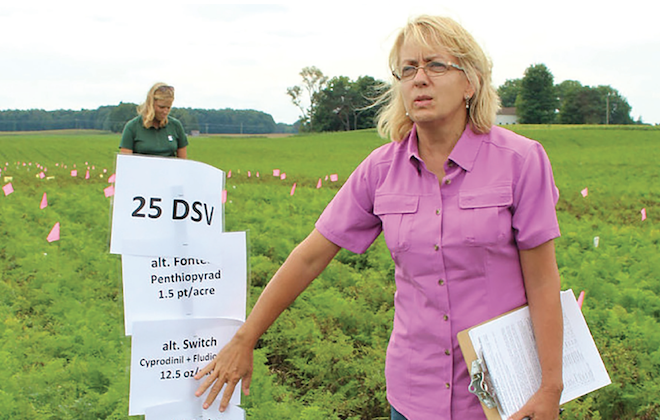
Mar 10, 2021Processing squash makes phytophthora a big threat
Squash grown for processing is in contact with the ground for a long time. “Processing squash has a longer time in the field than other cucurbits because of its longer time to maturity,” said Mary Hausbeck, vegetable pathologist in Michigan State University’s (MSU) Department of Plant, Soil and Microbial Sciences.
That makes phytophthora a serious issue because the fruit can be in direct contact with this highly destructive, soil-borne pathogen.
“Squash fruit may look good at first glance, but when you pick it up and turn it over the infection can be seen,” Hausbeck said. She spoke on managing phytophthora blight on processing squash at the recent Great Lakes Fruit, Vegetable & Farm Market EXPO, held virtually.
The economics of controlling phytophthora in processing squash are difficult. “It’s quite a struggle,” Hausbeck said. “Due to the long time needed for the processing squash to mature, many fungicide sprays may be needed to protect it from phytophthora fruit rot, and that’s expensive.”
The roots, crowns, stems, leaves and fruits of processing squash are susceptible to phytophthora. Crown rot early in the season and fruit rot late in the season are the two stages where the disease must be controlled.
“Getting squash to the finish line is a two-step process,” Hausbeck said. “First, the plants must be kept alive so that fruit can be produced. Then, the fruit must be protected from infection until harvest.”
Crown rot control requires using soil-applied fungicides early. This includes soil drenches and banded sprays at transplanting, and season-long drench and drip applications targeting the plant crown and soil. Treat more frequently in rainy weather.
Orondis, Elumin and Presidio are options for soil and drip applications. Ridomil Gold (mefenoxam) is also an option, but some phytophthora isolates are known to develop resistance to mefenoxam-based fungicides if they are overused.
Some squash varieties have some resistance to phytophthora and that can really help.
In MSU trials, the varieties Butternut Ultra, Buckskin, New England Cheddar and Dickinson developed crown rot in less than 20% of the plants in a trial that included high levels of phytophthora and no fungicide treatments.
In the same trial, Space Station, NK-580, Autumn Cup and Thunder had crown rot in about 60% of the plants. Delica, Sunshine, Sweet Mama and Golden Delicious had crown rot in more than 90% of the plants.
Resistance to fruit rot may develop later in the season during fruit formation and some varieties become more resistant as they mature.
MSU researchers evaluated whether the fruit of different hard squash varieties would become infected when challenged with phytophthora at seven, 14 and 21 days after pollination.
The varieties including Buckskin, New England Cheddar, Butternut Ultra and Dickinson showed the most dramatic results. The fruit of these four varieties became more resistant to phytophthora rot once they reach an age of 21 days after pollination than the other varieties tested. These same varieties were also the ones more resistant to crown rot.
“Select a variety that is less susceptible to crown and fruit rot and build a disease control program from there,” Hausbeck said. “If you can use some of these cultivars that my program has identified as having some resistance to this destructive pathogen, you can begin with a good foundation, and the fungicides can provide the needed additional control.”
Begin foliar fungicide applications before symptoms appear when the fruit are very young and developing, as they are very susceptible to infection at that stage. Reapply regularly and remember to rotate among fungicide classes.
Orondis Ultra, Presidio, Elumin, Revus are preferred choices for foliar sprays to the fruit. Ridomil-based, pre-mixed fungicides may be an option but resistant phytophthora could develop and become an issue.
Apply sprays at greater than 40 gallons per acre because the fungicides must penetrate the leaf canopy and cover the fruit in order to provide protection. Systemic fungicides applied only to the leaves do not protect the fruit.
Timely harvest so that the fruit is not left on the soil any longer than necessary in fields with a known phytophthora history is an important strategy.
Phytophthora has many vegetable hosts, so rotation crops should be carefully chosen.
Managing phytophthora means managing water to prevent standing water in the fields following a rainstorm. Use well-drained sites for growing processing squash and don’t plant in low areas of the field.
Irrigating with surface water that may be contaminated with phytophthora is always an issue. Irrigating with contaminated surface water is essentially applying phytophthora to your crop. Using surface waters as an irrigation source is not a recommended practice and allows phytophthora to spread to clean ground quickly.
Avoid spreading phytophthora from fields known to be contaminated to clean fields.
“Work your known phytophthora-contaminated fields last and then power wash the equipment to remove the soil to limit the spread to your clean fields,” Hausbeck said.
— Dean Peterson, VGN Correspondent
















